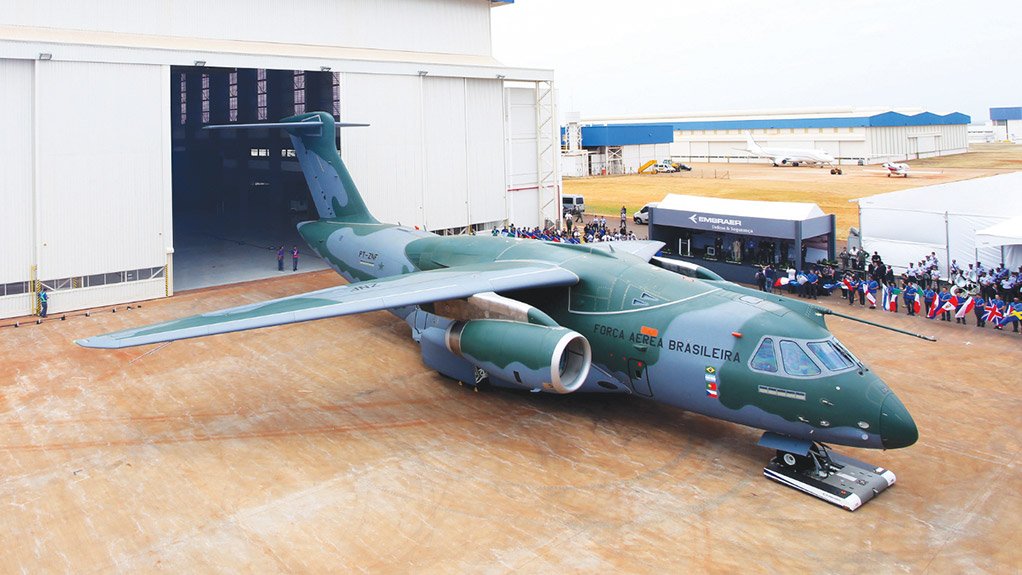
BIGGEST PROJECT YET The first prototype KC390 during its roll-out ceremony
Photo by: Embraer
Brazilian aircraft manufacturer Embraer rolled out the first prototype of its KC390 military transport and air-to-air refuelling aircraft at its Gavião Peixoto plant, in São Paulo state, on October 21. The aircraft is the biggest type yet developed by the company and probably the biggest aircraft ever developed in the southern hemisphere. The development of the aircraft has cost about $1.94-billion. “This significant milestone of the KC390 programme demonstrates Embraer’s ability to manage such a complex and high-technology project and to perform it on track,” enthused Embraer Defence and Security president and CEO Jackson Schneider. “It paves the way for the beginning of the ground tests to prepare for the first flight.”
Those ground tests will include systems evaluations, engine ground runs and vibration tests. This first aircraft will be followed by a second prototype and then by 28 production aircraft for the Brazilian Air Force (abbreviated to FAB in Portuguese). The acquisition of these aircraft will cost the FAB $2.85-billion. Five other countries (Argentina, Chile, Colombia, the Czech Republic and Portugal) are currently planning to buy another 32 of the type. The company expects to sell 100 of the aircraft over the next ten years.
Powered by two turbofan engines, the KC390 will, Embraer states, have the lowest total life-cycle costs and highest availability in its class. It will be able to operate from short and semi-prepared airfields. It is fitted with a complete fly-by-wire flight control system. Embraer points out that it is the first aircraft in its class (not category) to be designed and built from scratch in decades. The programme also involves companies in Portugal, the Czech Republic and Argentina.
The programme is being largely funded by the FAB. “The KC390 will be the backbone of the FAB’s air transportation network,” affirmed FAB Commander Lieutenant-Brigadier (equivalent to Lieutenant-General) Juniti Saito. “It will be able to operate in both the Amazon and Antarctica. The jet engines give the aircraft enormous agility in fulfilling all of its missions, faster and better.”
The new aircraft will have a tactical payload of 16 t and a logistical mission payload of 23 t. With a 19 t payload it will have a range of 2 000 nautical miles (nm), rising to 2 600 nm with maximum fuel and a payload of 14.7 t. Ferry range will be 3 250 nm.
In its press release, Embraer described the KC390 as “a significant advance in terms of technology and innovation for the Brazilian aeronautics industry. The aircraft is designed to establish new standards in its category, with a lower operating cost and the flexibility to perform a variety of missions: cargo and troop transport, troop and cargo air delivery, aerial refuelling, search and rescue and combating forest fires, among others”.
Another major development for the Brazilian group came less than a week later when, on October 27, Brazil signed a $5.8-billion contract with Swedish group Saab to buy 36 new generation Gripen multirole fighters. The order will comprise 28 single-seat Gripen E aircraft and eight two-seat Gripen F aircraft. The deal involves significant technology transfer. Embraer will be Saab’s strategic partner in this programme and will play an important role in the development of the Gripen F (currently, the Swedish Air Force intends to buy only Gripen Es for its own requirements, so Brazil is the first customer for the two-seater). While 21 of the aircraft will be assembled in Sweden – with the participation of some 150 Brazilian engineers and technicians – the remaining 15, including all the Gripen Fs, will be assembled by Embraer at Gavião Peixoto. The FAB hopes to be able to place follow-on orders later, which could increase the number of Gripens it acquires to 100.
Embraer’s commercial aircraft division also marked a milestone last month when, on October 17, the first metal was cut for the first prototype of the next generation E190-E2 jet airliner. The metal cutting, for the wing stub forward pressure bulkhead, took place at the company’s plant, in Évora, Portugal. The E190 is part of Embraer’s successful E-jet family and the -E2 updates the design with new engines, new wings, full fly-by-wire controls and improvements in other systems. Currently, the E-jet family comprises the E170, the E175, the E190 and E195, which range in capacity from 70 seats to 130 seats. Embraer plans to follow the E190-E2 with the E195-E2 and the E175-E2.